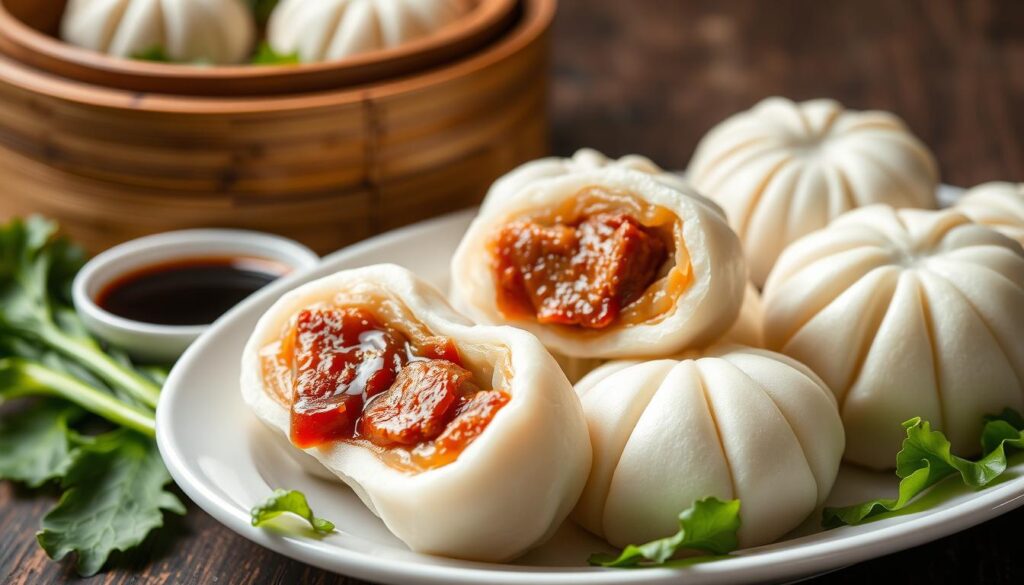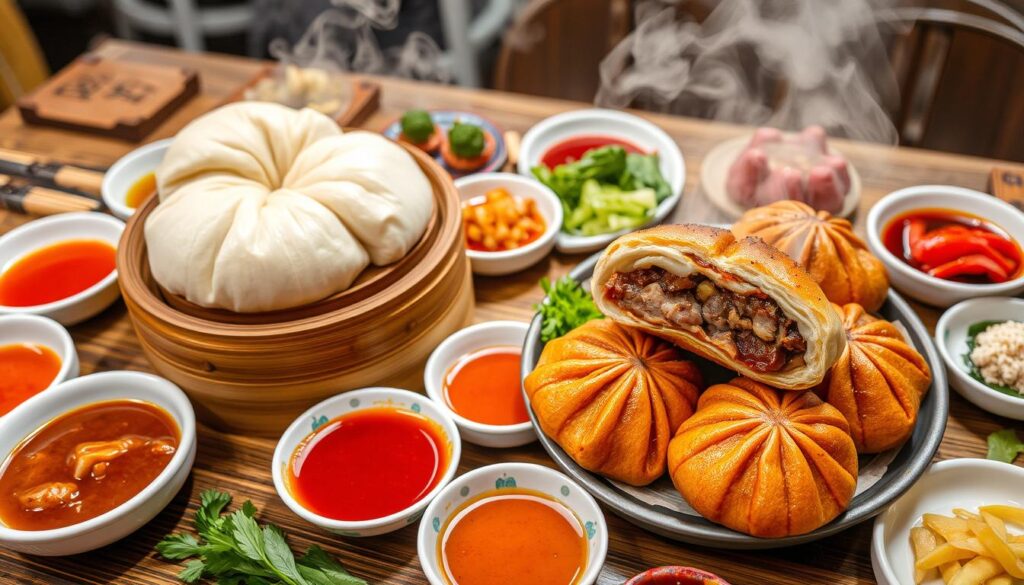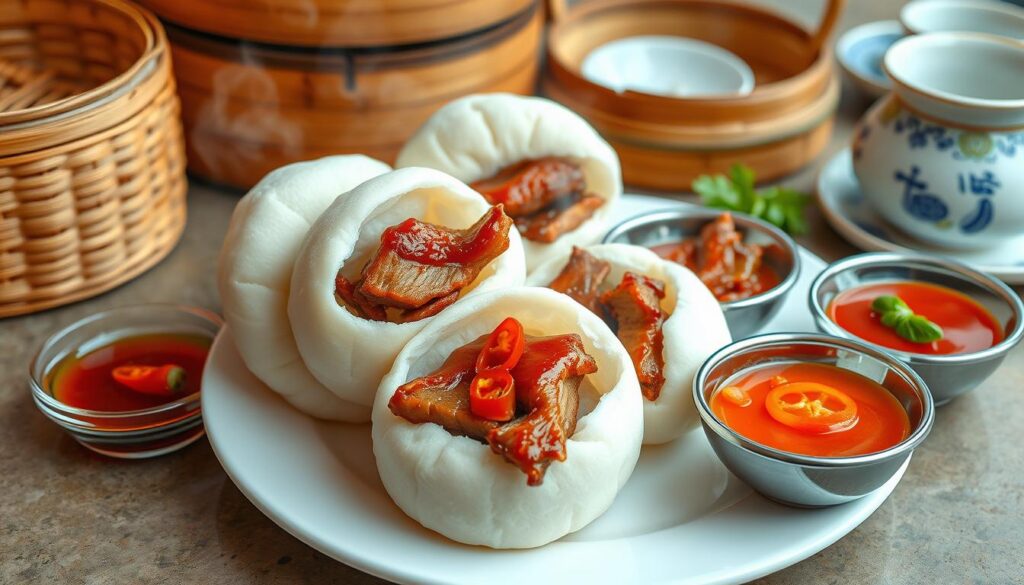
Growing up in a Chinese-American home, I found the joy of char siu bao. We’d go for dim sum on weekends. These soft buns filled with barbecue pork were more than food; they connected me to my roots.
Chinese dim sum has a special power to unite people. Char siu bao is more than a tasty snack; it’s a heartwarming tradition. Each bun shares a story of cooking passed down through generations.
Whether you’re new to dim sum or a fan, char siu bao offers a peek into Chinese cooking. These beloved buns have traveled far, becoming a favorite worldwide. They show how food can bridge cultures.
Key Takeaways
- Char siu bao is a quintessential part of Chinese dim sum cuisine
- The buns represent a perfect balance of sweet and savory flavors
- Steaming is the traditional cooking method for these delectable treats
- Char siu bao reflects the deep cultural significance of Cantonese cooking
- These buns are enjoyed globally, showcasing the universal appeal of dim sum
The Rich Heritage of Cantonese Dim Sum Culture
Dim sum dumplings are more than food; they are a key part of Cantonese culture. The name “dim sum” means “touch the heart.” It shows the deep bond people share over these tasty dishes.
Dim sum’s history is tied to old tea houses. Steamed buns and pork buns became central to a social dining experience. It’s more than just eating.
Origins of Tea House Traditions
Cantonese tea houses were places for people to meet and share food. Yum cha, or tea-drinking, turned meals into a shared ritual.
- Tea houses originated in Guangzhou province
- Typically served 30-50 different dim sum varieties
- Emphasized sharing and social interaction
Evolution of Dim Sum in Modern Times
Dim sum has grown globally, reaching new fans. Today, pork buns and other treats are enjoyed everywhere. The global dim sum market is expected to hit $1.4 billion by 2026.
“Dim sum is not just food – it’s a celebration of culture, connection, and culinary artistry.”
Cultural Significance in Chinese Cuisine
Dim sum is more than a meal; it’s a cultural bond that ties generations together. About 70% of Chinese restaurants worldwide serve Cantonese dishes. This shows the cuisine’s big impact globally.
- Symbolizes family unity
- Represents culinary craftsmanship
- Demonstrates intricate cooking techniques
Understanding Char Siu Bao Varieties
Explore the tasty world of char siu bao. These buns are a mix of traditional and modern flavors. They come in two main types: steamed and baked buns.
Steamed buns, or 蒸叉燒包 (zhēng chāshāo bāo), are soft and fluffy. They feel like they melt in your mouth. On the other hand, baked buns, or 叉燒餐包 (chāshāo cān bāo), have a crispy outside and a golden color.
Regional Variations
Char siu bao has been loved by many cultures around the world. Each place has its own twist:
- Hawaiian cuisine calls it manapua
- Samoan version is keke pua’a
- Tahitian adaptation is chao pao
- Vietnamese variant is xíu páo
These buns are known for their variety of fillings. You can find everything from traditional char siu to unique mixes like pork, mushrooms, and quail eggs.
| Bun Type | Characteristics | Texture |
|---|---|---|
| Steamed Buns | Soft, white appearance | Light and fluffy |
| Baked Buns | Golden-brown exterior | Slightly crisp surface |
“The beauty of char siu bao lies in its ability to transform simple ingredients into a culinary masterpiece.” – Traditional Chinese Chef
Whether you like steamed or baked buns, you’re in for a treat. Each type takes you on a journey of flavors. Get ready for a delicious adventure!
Essential Ingredients for Perfect BBQ Pork Filling
Creating an authentic char siu bao starts with the right ingredients. You need premium ingredients for a mouthwatering barbecue pork filling. This journey begins with selecting the best ingredients for a dim sum classic.
Selecting the Right Cut of Pork
The foundation of a great barbecue pork filling is the meat. Pork shoulder is the best choice. It has:
- Optimal fat content for juicy filling
- Tender texture when properly prepared
- Superior ability to absorb marinades
Key Seasonings and Spices
Transform your pork filling with a blend of seasonings. These are the essential ingredients for authentic char siu bao:
- Chinese five-spice powder
- Light and dark soy sauce
- Oyster sauce
- Sesame oil
- Rice wine vinegar
Secret Sauce Components
Your barbecue pork filling gets a boost from a secret sauce. This sauce balances sweet, savory, and umami flavors. Consider these ingredients:
- 2 tablespoons sugar
- 1/2 cup chicken stock
- White pepper
- Shaoxing wine
“The art of char siu bao lies in the delicate balance of flavors within the pork filling.”
Pro tip: Use no more than 1 tablespoon of filling per bun. This prevents the bun from splitting during baking. With these ingredients, your barbecue pork filling will make your char siu bao amazing.
Mastering the Art of Bao Dough
Making the perfect dough is key for amazing steamed and baked buns. Your path to making top-notch pork buns starts with learning about dough preparation.
The base of excellent bao is choosing the right ingredients and perfecting your technique. For your dough, you’ll need:
- 300g all-purpose flour
- 150ml warm water
- Pinch of salt
- Small amount of sugar
Kneading is an art that turns simple ingredients into soft, fluffy buns. The trick is to build gluten through steady, rhythmic movements. Patience is your greatest ingredient.
“The secret to perfect bao is in your hands and heart” – Traditional Chinese Cooking Proverb
Different buns need slight changes in dough. Steamed buns want a softer, more elastic dough. Baked buns need a firmer dough to keep their shape.
Common dough problems include:
- Sticky dough: Add flour slowly
- Tough texture: Knead less
- Uneven rising: Make sure to rest it enough
With time, you’ll get the hang of making the ideal bao dough. It will be a tasty base for your favorite fillings.
Step-by-Step Preparation Techniques
Making authentic Chinese dim sum is all about precision and passion. The art of making char siu bao is a detailed process. It turns simple ingredients into culinary magic.
Dough Preparation Process
Your journey to perfect char siu bao starts with the dough. It’s important to choose the right flour. Mix 4 cups (500 grams) of low-gluten flour with all-purpose flour for the perfect texture.
Add 7 tablespoons of white spirits and 2 tablespoons of white sugar. This will make the dough more complex.
- Mix flour thoroughly
- Incorporate white spirits gradually
- Knead until smooth and elastic
- Rest dough for 12 hours for optimal fermentation
Filling Creation Methods
The pork filling is the heart of char siu bao. Use 2 1/3 pounds of pork shoulder, trimming it to about 2 pounds. Cut the barbecued pork into 1-square centimeter pieces for even distribution.
| Ingredient | Quantity | Purpose |
|---|---|---|
| Pork shoulder | 2 pounds | Primary protein |
| Oyster sauce | 1 tablespoon | Flavor enhancement |
| Marinade | 6-8 hours | Flavor absorption |
Proper Folding Techniques
Mastering the folding technique makes your char siu bao stand out. Portion each dough piece to 1 ounce. Practice making uniform, sealed buns to show off your skill.
“The beauty of char siu bao lies not just in its taste, but in the artistry of its creation.” – Traditional Dim Sum Master
With these techniques, you’ll make Chinese dim sum that’s as good as any restaurant. You’ll bring authentic flavors right to your kitchen.
Steaming vs. Baking Methods

Exploring char siu bao reveals two main cooking methods: steaming and baking. Each method adds unique qualities to these tasty roasted pork buns. They turn simple ingredients into delicious treats.
Steaming: The Traditional Approach
Steamed buns have a classic texture that captures the true essence of dim sum. To steam roasted pork buns, follow these steps:
- Line a bamboo steamer with parchment paper
- Arrange buns without touching each other
- Steam for 12-15 minutes at high heat
Steaming makes buns soft and fluffy with a delicate exterior. The moist environment keeps the buns tender.
Baking: A Crispy Alternative
Baked buns offer a different experience with a golden, crispy exterior. To get perfect results:
- Preheat oven to the correct temperature
- Brush buns with egg wash for shine
- Bake until golden brown
“The magic of char siu bao lies in the perfect balance between filling and cooking method.” – Dim Sum Master
Roasted pork buns can use both techniques. Chefs often steam the buns first, then bake them quickly. This creates a crispy outside and a soft inside.
Choosing Your Method
Your choice depends on what you like and the texture you want. Steamed buns stay true to tradition, while baked ones offer a modern twist.
Professional Tips for Restaurant-Quality Results
Making authentic Chinese dim sum needs skill and precision. Your char siu bao can go from home cooking to restaurant quality with a few expert tips. These tips will make your Cantonese cuisine experience better.
Temperature Control Secrets
Getting the temperature right is key for perfect char siu bao. Here are some professional tips:
- Use warm water between 100-110°F when activating yeast
- Proof dough in a consistently warm environment around 80-85°F
- Steam buns at precisely 212°F for optimal texture
Texture Enhancement Strategies
To get that fluffy bao texture, you need to be careful:
- Knead dough for exactly 15 minutes to develop gluten
- Allow 1 hour proofing in a draft-free space
- Create a 1:2 thickness ratio with thinner edges
Storage and Reheating Guidelines
Keep your delicious char siu bao fresh with these tips:
- Refrigerate fresh buns for up to 3 days
- Freeze uncooked buns for up to 2 months
- Reheat frozen buns by steaming for 8 minutes
- Allow 5 minutes resting time after cooking to prevent collapse
“The secret to great dim sum is patience and precision in every step.”
By using these techniques, you’ll make char siu bao that’s restaurant-worthy. It will show off the rich flavors of traditional Cantonese cuisine.
Serving Suggestions and Pairing Recommendations

Make your dim sum dumplings experience better with these serving tips. Pork buns are amazing when paired with the right sides. This turns a simple meal into a fun food journey.
Ideal Side Dishes
- Steamed white rice
- Stir-fried vegetables
- Pickled cucumber salad
- Egg fried rice
- Shrimp Mei Fun noodles
Dipping Sauce Sensations
Discover the best flavors of your char siu bao with these tasty dipping sauces:
| Sauce Type | Key Ingredients | Flavor Profile |
|---|---|---|
| Classic Soy Dip | Light soy sauce, black vinegar, sesame oil | Umami and tangy |
| Spicy Chili Oil | Chili flakes, garlic, hot oil | Spicy and aromatic |
| Zesty Twist | Yuzu juice, fresh lime, grated ginger | Bright and refreshing |
Beverage Pairings
Finish your dim sum meal with these drinks:
- Jasmine tea
- Oolong tea
- Light lager
- Sparkling water with citrus
Pro tip: Let your pork buns rest for a few minutes after cooking to enhance their texture and flavor.
Your homemade char siu bao will take you straight to the heart of Cantonese cuisine. Follow these serving tips for a great experience.
Conclusion
You’ve started an amazing journey into the world of char siu bao. You’ve learned how to make perfect Chinese dim sum and barbecue pork buns. Now, your home kitchen can feel like a real Chinese restaurant.
You can now make 16 char siu bao in under 3.5 hours. It’s important to pick the right pork and use ingredients like low-gluten flour and active dry yeast. This ensures your buns taste and feel just right.
These buns can be stored in the fridge for up to 3 days or frozen for a month. This makes cooking and preparing meals super easy.
Keep trying new things and tweaking recipes to your liking. The world of Chinese dim sum is full of traditions and flavors. Char siu bao is just the start of your food adventure. Your hard work will lead to even more tasty discoveries.
FAQ
What exactly is char siu bao?
Char siu bao is a traditional Chinese dim sum dish. It has a soft, fluffy bun filled with savory barbecue pork. You can steam or bake it, and it’s a favorite in Cantonese cuisine.
What’s the difference between steamed and baked char siu bao?
Steamed char siu bao have a soft, white exterior. Baked ones have a golden-brown, crispy surface. Both have the same tasty barbecue pork filling but look and feel different.
How do I store leftover char siu bao?
Store leftover char siu bao in an airtight container in the fridge for 2-3 days. To reheat, steam for 3-5 minutes or microwave with a damp paper towel. This keeps the bun fluffy.
Are char siu bao difficult to make at home?
Making char siu bao at home takes practice but is doable. Focus on making good dough, preparing the filling right, and steaming or baking well.
What are the essential ingredients for char siu filling?
Essential ingredients include pork, hoisin sauce, soy sauce, five-spice powder, oyster sauce, and shaoxing wine. These give the filling its unique sweet and savory taste.
Can I make vegetarian char siu bao?
Yes, you can make vegetarian char siu bao. Use tofu, mushrooms, or plant-based meat alternatives. The dough and cooking methods stay the same, offering a classic dim sum experience.
What drinks pair well with char siu bao?
Traditional pairings include Chinese tea like oolong or jasmine tea. For a modern twist, try light lagers, sparkling water, or crisp white wine. These drinks complement the rich barbecue pork filling.
How long does it take to prepare char siu bao from scratch?
Preparing char siu bao from scratch takes 2-3 hours. This includes making the pork filling, preparing the dough, resting, filling, and cooking. It’s a rewarding process for home cooks.

